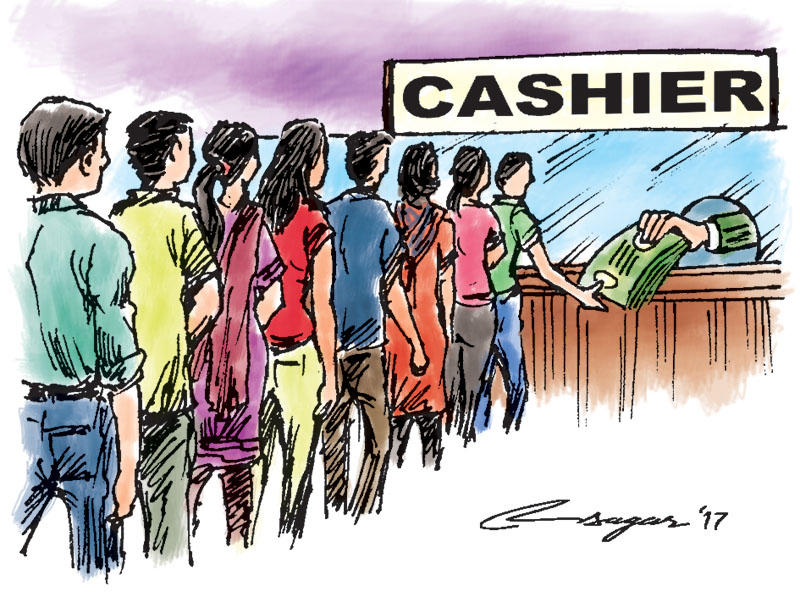Bank deposits: Structural problems
NRB again is in jeopardy this time — to intervene or not to intervene. Do they have choices? No. Hence, it is better to act sooner as the 2008 global meltdown has already proved that profits are private and the losses public
There is talk going on to keep unspent government expenditure in the banks call account at a going rate or further relax CCD ratio from the current level of 80%. IMF has already warned the latter.
What is worse than keeping tax payers’ money at a bank to help their growth or match the already lent funds mostly to the retail boom leveraged against the loan rates lower than the inflation and assets valued at an unfair market rate. NRB’s prudence will not let deplete the last source, and set up a bad precedent. We all as an economy have a tendency to forget things too fast, so the next level of riskiness is the revised benchmarks which will be a rule tomorrow bringing misfortunes to future generations. The rates were exactly the same — 12% p.a. interest rate payable monthly 5 years back! Did we ever learn from the past that interest rate and asset prices have cycles? Maybe not.
The problem is a mismatch in deposit to assets ratio or sources and uses of funds rather than the liquidity in the banks; it is not the cash crunch. Moreover, the problems are cited as structural weaknesses of the economy and leaving as it is for someone else to deal with it. The fact is, this will recur in a cyclical pattern due to known structural issues — low government expenditure has been a noted problem since long, it is equally relevant in the present context and will remain in future until and unless there is a stable sort of government, which looks very unlikely for the foreseeable future.
For a growth deprived nation, have not we witnessed cash piled in the government coffers for many years which elsewhere instead would have demanded public borrowings to fuel the growth? Needless to say, the remittance has remained so far the respite, mostly consumed due to the ‘hand to mouth’ problem than channeling it for investments. Had it been the liquidity issue the T-Bills would soar to double digits with interbank hovering above 10% p.a. by now. It is already two decades of labor migration for this nation, the time is closer when retirees come home. The period of growth phase shall be flat over a period of time. It is better to go back to the basics, let’s recall the role of the ‘invisible hand’ of the economics theory.
The questions are obvious and sound sweet — Does the competitive system give away the choices to anyone not to be aggressive and let go the opportunities someone else is capitalizing on, especially in banking? Capital by rule of economics is scarce, with a new rule in place — 4 times multiple in banks, pushing the growth to the limits is what the fraternity aims for. The epitome of the objective is grow the books and keep growing. Where is it coming from — ‘the growth’ when the GDP is grossly at the same level with higher inflation and consecutively nominal GDP lower than the loan growth rate? Discounting the inflow from labor markets on the source side, other parameters like local competitiveness by way of import substitution and exports is crippling everyday, no wonder the trade ratio has depleted to 92:8. Alas, it’s too late to ponder why this was not realized in the past especially by the private sector, and above all the banks?
At abnormal times, it’s worth stitching on time. The possible solutions are for the NRB to purchase good credit from banks on a securitization principle initially for six months of around 50-75 billion rupees which immediately eases CCD. Anyway, the real shortfalls should be less than 100B (roughly 5% of the total bank loans), a guesstimate only looking at the size of the economy.
The mismatch in tenor of deposit to long-term loans is widening with the growing banks’ book size, hence at least some of the sources (deposit or bond), preferably bond, to be offered matching the average tenor of the bank’s loan books. This creates a stable source of funds and market takes the risk of valuation than re-pricing by the banks. The risk gets passed on to the investors than the banks taking the risk themselves reducing the concentration on deposits to some degree with risk diversified to the different investing population. Let’s realize that the stable saving deposits of the banks may not remain stable all the time.
We need stricter guidelines for lending working capital to the corporate, as this is the cause of all the misuses and illnesses, cheap and easy to borrow, and mostly used for speculative bubble whether real estate or shares whenever opportunities are seen. Overdraft, Trust Receipts, and Demand Loan need a whole lot of redefinition of its uses based on Net Current Days along with the proportion of Net Current Assets.
With limited opportunities of alternative investments for people en masse, we require a mechanism that deposit rates are not suppressed to the levels that pensioners choke to survive and are compelled to take comfort in the riskiest assets and lose the principal itself. Too much money chasing the same assets naturally creates a bubble to break.
Lastly, panic is dangerous. Time heals and the situation will ease. NRB again is in jeopardy this time — to intervene or not to intervene. Do they have choices? No. Hence, it is better to act sooner as the 2008 global meltdown has already proved that profits are private and the losses public. Reducing losses is better than damaging the future prospects of the economy.
Ghimire is the Chief Executive Officer of NMB Capital






